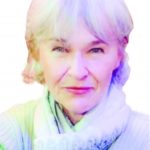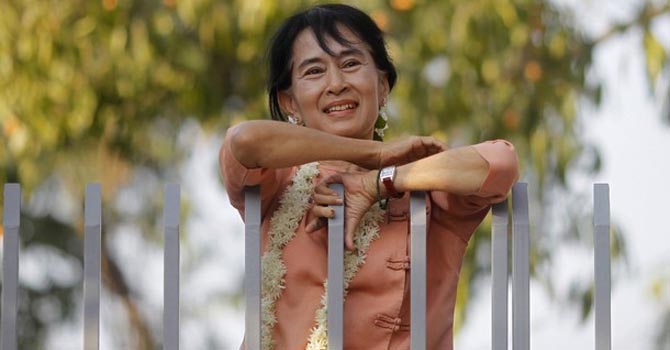The Legend of [Nobel Peace Laureate] Aung San Suu Kyi
NOBEL LAUREATES, 13 Mar 2017
“… or live long enough to see yourself become the villain.”
“So who is Aung San Suu Kyi … how can she travel the world to shill up investment in Myanmar while the military is carrying out a genocide?”
3 Mar 2017 – There has been a dramatic shift in media coverage of Aung San Suu Kyi since 2012, when she travelled to Oslo to pick up her 1991 Nobel Peace Prize as an icon of human rights of almost mythic stature. In her acceptance speech, she spoke of her Buddhist commitment to nonviolence, of solidarity with those suffering injustice, of the corrupting influence of fear in standing against repression and the power of human kindness. It was quite a performance – so stirring, that as she continued travelling in Europe and the US to pick up other human rights awards, few thought to ask her about the genocidal violence against Rohingya Muslims going on at the same time in Myanmar.
News about the apartheid conditions and squalid concentration camps in Arakan for the Rohingya displaced by the 2012 violence began to snap many out of their adulation to ask why Suu Kyi, the exemplar of human rights compassion and courage, was as silent as a block of cement about the persecution of the Rohingya. When asked about it, Suu Kyi would speak in evasive abstractions about the “rule of law” to suggest lawless rampaging among Rohingya. She more often dropped the Buddhist shtick to make clear that she rejected the notion of persecution and violence against Rohingya; she portrayed it as a communal conflict between Buddhists and Muslims with guilt on both sides and suggested strongly that the Rohingya had brought it on themselves, especially with their higher birth-rate which made Buddhists feel threatened: the classic fear-mongering of ethnic cleansing used everywhere.
Rohingya have been ruthlessly persecuted for decades stemming from British colonialism but the 2012 wave of violence against them and the refugee crisis in the Andaman Sea finally made the world notice. In May 2015, at least 25,000 Rohingya fled persecution in Myanmar on unsound boats. The world watched in disbelief and horror as thousands drowned (and no one knows how many) because no government would rescue them or allow them to land and no human rights agency has ever tried to make an accounting of those who drowned – as if their lives had no value. As evidence of genocide became more public and outrage grew, many were still asking why Suu Kyi remained silent but many more understood that her silence had the distinct malodour of collusion.
After becoming Myanmar head of state in March 2016, Suu Kyi dumped the equivocations entirely. It was more than evident the military was still running the country but with the human rights and democratic facade she cynically provided, especially through setting up phoney investigative commissions like the Kofi Annan whitewash commission. Suu Kyi has shown her hand by fronting for the 2016 offensive against Rohingya which has caused nearly 70,000 to flee to Bangladesh with gruesome reports of soldiers torching homes, extrajudicial executions, mass rapes and torture, forced disappearance, and mass incarceration. Incredulity about her silence has finally turned to a chorus of accusations of collusion with the military. Her glory days are over. It’s all downhill from here.
So who is Aung San Suu Kyi? How did such a human rights icon hit the skids from such Olympian heights to denying a genocide even acknowledged by the political lowbrows of the US Congress? A genocide denounced by Pope Francis, seven Nobel Peace Laureates, the UN, EU, human rights organisations, the Dalai Lama and prestigious university researchers? How does she think she can pull off denial in the face of irrefutable evidence and international opposition? How can she travel the world to shill up investment in Myanmar while the military is carrying out a genocide?
The truth of the matter is, “there isn’t much there-there” to Suu Kyi’s human rights credentials. Her prestige is mostly fabrications, family lineage, and knowing the right people. She had been out of the country for schooling and work since the age of 15 in 1960, first living in India with her widowed mother who was a diplomat for the military junta, then to the US for schooling and work, to England where she married and had two sons, to Bhutan where her husband tutored the feudal rulers, and then back to England.
In 1988, at the age of 43, after living away for 28 years, she incidentally returned to Myanmar to care for her ailing mother and got involved in the 8888 Uprising, not as an organiser but as a rally speaker. The 8888 Uprising was a national democracy movement against military rule involving millions from every part of the country in protests and general strikes. The uprising began in March and was ended in September 1988 when the military regained control by massacring an estimated 10,000 activists; thousands fled the country to avoid the same fate.
It requires explanation how Suu Kyi went from living an apolitical domestic life outside the country to leading a revolutionary movement in a matter of weeks without serving any political apprenticeship. Her father Aung San, a leading political figure opposing British colonialism, is considered an architect of Burmese independence, and founded the Myanmar Armed Forces. He was assassinated in 1947 when Suu Kyi was only two. That pedigree seems to be the substance of her political credentials and must be what got her placed at the centre of Burmese politics.
She was recruited to help found the National League for Democracy (NLD) in September 1988 after the 8888 Uprising was crushed. The founding officers of the NLD were former high-level generals in the military, some of whom were involved in bloody crackdowns on student demonstrators in the 1960s and 70s, and none of whom were politically progressive. This makes the NLD’s political agenda and her involvement with it questionable, to say the least. But they positioned themselves as the political opposition to military dictatorship.
“It was more than evident the military was still running the country but with the human rights and democratic facade she cynically provided, especially through setting up phoney investigative commissions like the Kofi Annan whitewash commission.”
While thousands of activists in the 8888 Uprising were forced to flee to other countries to avoid being executed, disappeared, or jailed, Suu Kyi was placed under house arrest for 15 of the next 20 years. She was a political prisoner, but her detention is hardly comparable to the gulag most dissidents faced. She lived in her family mansion on a lake in the most exclusive residential district of Yangon, attended to by servants. What convinced her to leave her husband and 13 and 17-year-old sons in England to live housebound for nearly two decades?
She received the first of her now nearly 150 awards and honorary degrees in 1990 and the Nobel Peace Prize in 1991. For what? Outside of some speeches at 8888 movement rallies, signing on to the formation of the NLD, and running once for office, there isn’t a single recorded instance of Suu Kyi sticking her neck out for human rights. What she had, through both parents and several other relatives, was deep connections to the military. This is not to imply it was some kind of bizarre conspiracy to keep her housebound for several years so she could eventually serve as a front office for the junta. But there are some unanswered questions. And of course, her connections are what kept her alive rather than suffer the fate of thousands of other dissidents with substantial and legitimate human rights credentials who were either jailed, killed, or in exile.
___________________________________
 A long-time activist in the labour, socialist, and social movements (including antiwar, Palestinian solidarity, civil rights, women’s rights, immigrant rights, and disability rights). She tweets at @mscully94 and her work is available at maryscullyreports.com
A long-time activist in the labour, socialist, and social movements (including antiwar, Palestinian solidarity, civil rights, women’s rights, immigrant rights, and disability rights). She tweets at @mscully94 and her work is available at maryscullyreports.com
The Nobel Peace Prize 1991 was awarded to Aung San Suu Kyi “for her non-violent struggle for democracy and human rights.”
Go to Original – pakistantoday.com.pk
DISCLAIMER: The statements, views and opinions expressed in pieces republished here are solely those of the authors and do not necessarily represent those of TMS. In accordance with title 17 U.S.C. section 107, this material is distributed without profit to those who have expressed a prior interest in receiving the included information for research and educational purposes. TMS has no affiliation whatsoever with the originator of this article nor is TMS endorsed or sponsored by the originator. “GO TO ORIGINAL” links are provided as a convenience to our readers and allow for verification of authenticity. However, as originating pages are often updated by their originating host sites, the versions posted may not match the versions our readers view when clicking the “GO TO ORIGINAL” links. This site contains copyrighted material the use of which has not always been specifically authorized by the copyright owner. We are making such material available in our efforts to advance understanding of environmental, political, human rights, economic, democracy, scientific, and social justice issues, etc. We believe this constitutes a ‘fair use’ of any such copyrighted material as provided for in section 107 of the US Copyright Law. In accordance with Title 17 U.S.C. Section 107, the material on this site is distributed without profit to those who have expressed a prior interest in receiving the included information for research and educational purposes. For more information go to: http://www.law.cornell.edu/uscode/17/107.shtml. If you wish to use copyrighted material from this site for purposes of your own that go beyond ‘fair use’, you must obtain permission from the copyright owner.
